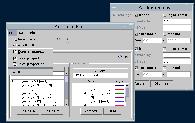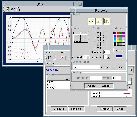|
JPlot makes graphs of data files. For example, the following set of
Y1, Y2 and Y3 data is a perfectly legal format:
0.1 22 1e-4
0.2 34 1.3e-4
0.3 44 1.5e-4
0.5 51 1.6e-4
...
Loading this file in JPlot allows you to select between column
1, column 2 and column 3 for building the
graph. For example, you might want to show columns 2 and 3 as a
function of column 1.
It is possible to make column selection much more explicit by
specifying the names of the columns in the data file. For example, the
above data could also be written as follows:
# First experiment H3/LH/1002 (4 batches)
# On 12/12/1998
# column 1: weight (g)
# column 2: volume (ml)
# column 3: concentration (molal)
0.1 22 1e-4
0.2 34 1.3e-4
0.3 44 1.5e-4
0.5 51 1.6e-4
...
Loading this file in JPlot allows you to select between weight
(g) , volume (ml) and concentration (molal) for
building the graph, hence much more explicit and user-friendly than
the anonymous columns of the previous example.
JPlot allows to add a specific character to lift the pen (*). For
example, the following datafile draws a graph with straight lines
defined by two couples of (X,Y) data. And note this nifty feature of
JPlot: it can read labels from a datafile, i.e., the label followed by
the position (x,y) and, evt., the rotation:
# This should be a 'normal' 2D graph but the special
# character '*' will lift the pen (discontinuous lines)
#
# label: "Field 1", 4, 11
# label: "Field 2", 9.5, 4.4
# label: "Field 3", 5.1, -1
# label: "Field 4", 10.4, -8
# label: "rotated label 1",10.3, 13 11
# label: "rotated label 2",3, -4 11
2 -3
10 -10 *
2 8
6.9 1.5
9.2 -4.5
12 -8 *
9.2 -4.5
9.2 -9.3 *
6.9 14
6.9 1.5 *
2 18.3
12 10
X- and Y axes labels can be added using the xlabel and ylabel
keywords, e.g. :
# label: "Field 1", 4, 11
# label: "Field 2", 9.5, 4.4
# label: "Field 3", 5.1, -1
# xlabel: "frequence (Hz)"
# ylabel: "performance (Tf)"
(data follows)
Using axes labels in datafiles is not recommended, however. At each
reload of the datafile, the axes labels are added to the graph. Those
who need such a feature should use the sources and write a method
which update the axes labels via a resource file.
|
 Latest version:
1.2.2 May 22, 2003
Latest version:
1.2.2 May 22, 2003
![]() Cliquez ici pour une version
franšaise
Cliquez ici pour une version
franšaise





